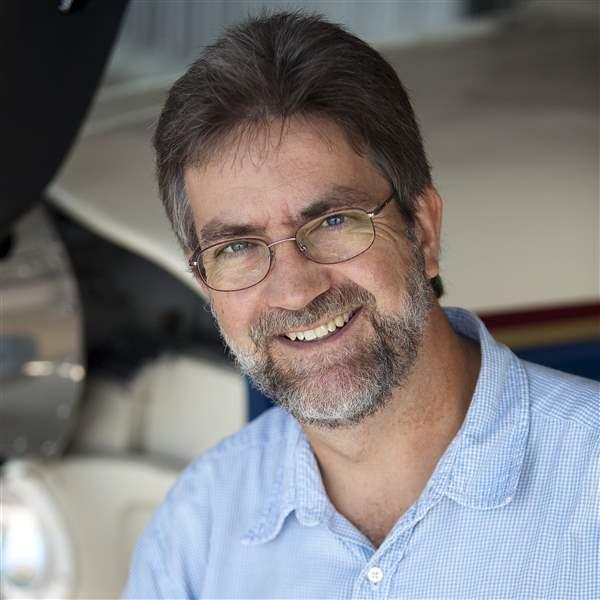New Mexico enchants aviators
AOPA Fly-In guests include 5,000th Rusty Pilot
New Mexico lived up to its nickname, "The land of enchantment," as 4,307 pilots, aircraft owners, and enthusiasts were enchanted by an array of aviation activities during the second of AOPA’s four 2018 Regional Fly-Ins, held in Santa Fe Sept. 14 and 15.
As has become the tradition for AOPA’s regional events, Santa Fe offered a variety of in-depth Friday workshops and shorter Saturday seminars, a large exhibit hall, and 40 static display aircraft, interspersed with a Barnstormers Party held under dazzlingly clear skies Friday evening and a pancake breakfast Saturday morning, and concluding with a Pilot Town Hall Saturday afternoon.
David Slaughter flew up from San Antonio, Texas, with a friend in a Cirrus to volunteer on the airside, parking airplanes. “It’s been a lot of fun,” he said. “I love the weather here, although it was a little nippy in the morning.” He had so much fun attending AOPA's Norman, Oklahoma, Fly-In last year he came back for more.
Bill Monteleone of Aliso Viejo, California, currently flies a Diamond DA40 from John Wayne Airport and plans to buy an airplane—likely a Beech Bonanza A36—in the next year, so he attended the owner-performed maintenance workshop. As a mechanical engineer he likes the idea of performing maintenance based on condition, and not simply time. “It’s super interesting to me that this philosophy is new to the maintenance guys,” he said. “It really puts a lot of power back in the hands of the owners.”

Tennessee flight instructor and designated pilot examiner Catherine Cavagnaro told the story of an engine failure she simulated during a commercial pilot checkride in a Piper Arrow. The applicant was following his checklist but was not getting the expected performance. “You’ve got to pull that [constant-speed] prop all the way back to coarse. It dramatically extends your glide range,” she said, adding that step did not appear on the applicant’s checklist—although it is included in the amplified procedures. Cavagnaro then noticed that the FAA’s Airplane Flying Handbook says to push the prop forward, to fine pitch. “That’s the worst thing you could do. Sometimes you have to read critically.” The FAA will update the book, she noted.
During her Saturday afternoon seminar, Cavagnaro suggested a good recurrent training strategy to her audience. “Find something that scares you the most, then go train for it in a controlled, safe environment,” she said.
“We’re on the cutting edge of drones, and it’s our responsibility to plan that path properly,” Kat Swain, AOPA senior director of UAS Programs, told members of the Professional Aerial Photographers Association and other drone operators during the weekend. “The drone industry moves very fast, and it’s important to stay up to date.” The FAA is trying to streamline the waiver process, which authorizes operations outside of the 14 CFR Part 107 rules, and faster authorizations—allowing drone operation in controlled airspace—are coming with the Low Altitude Authorization and Notification Capability, or LAANC, an FAA/industry collaboration being deployed now.

Amundsen Schmitz, 4, of Portales, New Mexico, may have been the youngest pilot at the show; his father, Arlan, said that when he is riding in the right seat of their Cessna 185, Amundsen doesn’t hesitate to bank the airplane to the right when he wants to see a subject of interest on the ground. They flew to the Idaho backcountry this summer, he added.
Katie Pribyl, senior vice president of AOPA's aviation strategy and programs, introduced the 5,000th inactive pilot to get back in the air through AOPA’s Rusty Pilots program. “My last flight was actually 2002. I thought there was no way I could go through all that again; it was such a pain the first time,” said Ted Malone of Scottsdale, Arizona.
When Malone signed up for a Rusty Pilots course in Scottsdale, he thought it was going to be a waste of time. “What really shocked me was the material was simple and well done,” he recalled. “Everything they talked about, I remembered. It really came together when I got in the plane with the instructor. When that plane rotated, it was like I went back 17 years.”

Malone flew about two hours to Santa Fe in a Cessna 182 with his wife, Mary—their first cross-country flight together. But Santa Fe’s 6,349-foot elevation didn’t intimidate him. “We used to live in Colorado and the last flight I did [before becoming inactive] was in Colorado, at about the same elevation as here.”
Baker introduced New Mexico Rep. Brian Egolf (D-47), speaker of the house, who noted that 10 of the state’s 70 representatives are pilots. “General aviation plays a big role in the state of New Mexico,” Egolf said, encouraging the audience to reach out to their own state legislators and let them know that GA is important to them.

Baker and AOPA senior staff discussed the AOPA Foundation and its fundraising activities, the ongoing You Can Fly initiative, GA safety and the AOPA Air Safety Institute’s accomplishments, and AOPA’s efforts surrounding egregious FBO pricing—which has led to creation of an airport access watch list. “This effort is getting action,” Baker said, noting that several airports are taking such steps as adding public transient parking or seeking an additional FBO to provide competition.
Before adjourning to the ice cream social, Bill Blake was presented a Lightspeed headset and a one-year subscription to Garmin Pilot for flying the longest distance to the Santa Fe Fly-In. Blake—a former Illinois director of aeronautics and AOPA regional representative who retired to Venice, Florida—flew his Cessna Turbo 182 1,311 miles to attend the event.
















